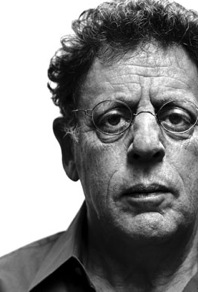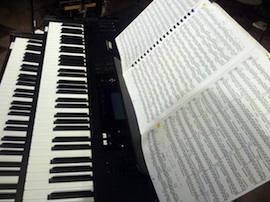At intermission of the second to last concert in Philip Glass’ Days and Nights Festival last Friday, a throng formed around the music stands, with patrons apparently literate in music examining the notation; lines and lines of ceaseless mind-blurring notes notated pitch by pitch, rhythm by rhythm — an unending stream of notes. How does the eye follow without getting lost? How do the fingers stay strong and steady for such lengths of time with no break? How does the brain maintain its focus?

These questions give Glass’ music its mystique. His style is so bravely different and so narrowly defined that he has become one of the most identifiable composers around. It is not only the repetitive aspect of this music (which I focused on in my review of the first concert of the festival) but also the timbral aspect that make him instantly recognizable. Especially in his film music, Glass conjures distinct sound colors as his musical fingerprint. On this evening, it was a very heavy dose of synthesized organs — four of them — played by the composer himself, Michael Riesman, Mick Rossi, and Lisa Bielawa, who also doubled as amplified soprano. Sopranos usually take over and warble on center stage but Bielawa blended into the ensemble, singing steady solfège with all the precision of an orchestral player.
In Dan Dryden’s live sound mix, the sound character for the entire evening was very intense. With organs blaring and overwhelming everything else, the winds act as a faint sound color in the distance, softening and humanizing the organ sound but not really achieving a distinct sound profile. The vocals were clearly audible, swimming in a stormy sea of sound. Even though the vocals were not the center of the mix, the ear still gravitates towards the human voice.

Sound design (Kurt Munkacsi), along with mixing amplifying, was a huge element of this of this concert, with speakers suspended strategically overhead. This technological art is often overlooked as instrumentalists steal the spotlight (literally and figuratively). And speaking of spotlights, the lighting work (by David Moodey) in the festival was also very effective, setting a mood (along with the sound design) somewhere between a rock concert, a movie theater, and a classical concert.
This concert was one of a two-part “Forty Year Retrospective” of Philip Glass’ compositions. From Music in Similar Motion (1969) to Civil warS (1984) to San Mandala (1997) everything had that distinct Glass fingerprint, with slight changes in tempo, keys or patterns swirling in the air. There are countless mini-patterns interplaying and resounding between the instruments and a long time to explore all of them, moving around in the engulfing sound, playing catch-up with the shifting patterns. Some pieces stop as instantly as they start, hitting a wall of silence exactly together without any warning. Other pieces do have warnings — suddenly a new figure is introduced, significantly different from everything else that came before it. This new figure acts as a coda of sorts, heralding the end. This was the case, for example, in the last seconds of the encore ("Spaceship" from Einstein on the Beach). A strange unison chromatic line suddenly broke the unyielding pattern of notes: This little surprise was the kicker for the whole concert. Glass played in the ensemble on the less intricate parts — the hard stuff with the fast arpeggios was apparently given to music director Michael Riesman. Glass mumbled the titles in breaks between pieces even though they were listed in the program. But with the absence of detailed program notes, couldn’t he at least say something about the music rather than just tiredly announcing what they were? He appeared on stage with serious, tired expression (as if it had been a long festival), perhaps with a hint of a dry smile when he thanked the individual performers and staff members by name.
While playing, Glass would occasionally give big nods — I couldn’t tell if they were cues marking convergence points for performers or if he was nodding off in his own separate world. This summer, he brought that world to a small barn in idyllic Carmel Valley. If the festival’s vision comes to fruition, Philip Glass’ legacy will have a permanent home in Big Sur. Listening to music over there will be truly magical.

